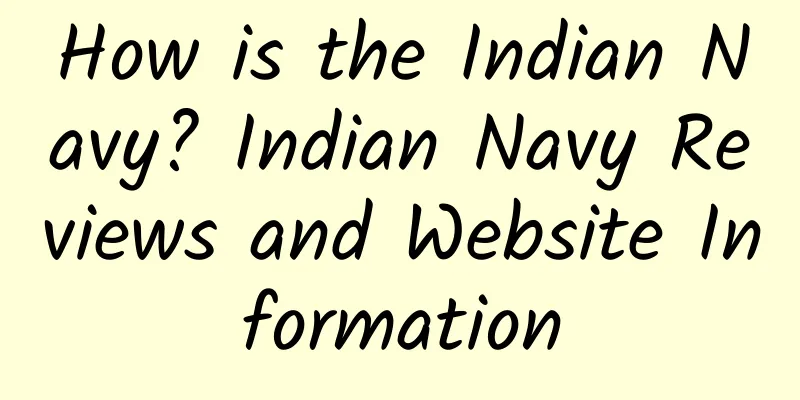How is the Indian Navy? Indian Navy Reviews and Website Information

|
What is the Indian Navy website? The Indian Navy (Bhartiya Nāu Senā), formerly the British Royal Indian Navy, is the fifth largest navy in the world, with 55,000 personnel, including 5,000 naval aviation and 2,000 marines; it has more than 155 ships, including the aircraft carrier INS Viraat, jet fighters such as INS Viraat. Website: indiannavy.nic.in The Indian Navy (Bhartiya Nāu Senā) is the maritime armed force of the Republic of India, with a history dating back to the East India Company Navy, founded in 1612. However, the modern Indian Navy was officially established after India's independence in 1947, and its predecessor was the British Royal Indian Navy. Today, the Indian Navy has become the fifth largest navy in the world, with approximately 55,000 active personnel, including 5,000 naval aviation and 2,000 marines. The Indian Navy is large in size, with more than 155 ships, including aircraft carriers, destroyers, frigates, submarines and other types of ships. History of the Indian NavyThe origins of the Indian Navy can be traced back to the 17th century, when the East India Company formed a maritime force to protect its trade interests. Over time, this force gradually developed into the British Royal Indian Navy. After India's independence in 1947, the British Royal Indian Navy was handed over to the Indian government and became the predecessor of the Indian Navy. In the following decades, the Indian Navy has undergone many modernization reforms and expansions, gradually developing into a maritime force with regional influence. During the Cold War, the Indian Navy played an important role in the Indian Ocean region. In particular, in the 1971 Indo-Pakistani War, the Indian Navy demonstrated its strong combat capabilities and successfully blocked the coastline of East Pakistan (now Bangladesh), making an important contribution to India's victory. Since then, the Indian Navy has continued to expand its size and capabilities, gradually introducing advanced ships and weapons and equipment, including aircraft carriers, destroyers and submarines. Organizational structure of the Indian NavyThe Indian Navy's organizational structure is divided into multiple levels, including the Naval Headquarters, Fleet Command and various local commands. The Naval Headquarters is located in New Delhi and is responsible for formulating and implementing the Navy's strategy and policies. The Fleet Command is responsible for managing and commanding the Navy's combat ships, which are usually divided into the Eastern Fleet and the Western Fleet. In addition, the Indian Navy also has several local commands responsible for the defense and operations of specific areas. The Indian Navy's active personnel include naval officers, non-commissioned officers and sailors. Naval officers usually graduate from the Indian Naval Academy and can be officially appointed after rigorous training and assessment. Non-commissioned officers and sailors join the Navy through recruitment and training. They perform various tasks in ships and bases, including navigation, maintenance, combat, etc. Indian Navy Ships and EquipmentThe Indian Navy has more than 155 ships, including aircraft carriers, destroyers, frigates, submarines and other types of ships. The following are some of the main ships and equipment of the Indian Navy: aircraft carrierThe Indian Navy currently has one active aircraft carrier, the INS Vikramaditya. The ship was originally the Admiral Gorshkov aircraft carrier of the Soviet Navy and joined the Indian Navy in 2013 after modernization. The INS Vikramaditya can carry multiple MiG-29K jet fighters and has a strong air strike capability. In addition, India is also building the domestically produced aircraft carrier INS Vikrant, which is expected to be commissioned in 2022. INS Vikrant is India's first domestically produced aircraft carrier, marking a major breakthrough in India's shipbuilding sector. DestroyerThe Indian Navy has several destroyers, including the Kolkata-class and Delhi-class destroyers. The Kolkata-class destroyers are among India's most advanced destroyers, equipped with advanced radar systems and missile weapons, and have strong air defense, anti-ship and anti-submarine capabilities. FrigateThe Indian Navy's frigates include the Shivalik-class and Talwar-class frigates, which are equipped with advanced weapon systems and can perform a variety of missions, including escort, anti-submarine and maritime patrol. submarineThe Indian Navy has a number of conventional and nuclear submarines. Conventional submarines include Kilo-class and Scorpène-class submarines, which have good concealment and combat capabilities. In addition, India also has a domestically produced nuclear submarine, INS Arihant, which is India's first strategic nuclear submarine and has the ability to launch ballistic missiles. Other shipsThe Indian Navy also has a number of patrol ships, landing ships, minesweepers and auxiliary ships, which play an important role in tasks such as maritime patrol, logistics support and maritime rescue. Indian Navy's aviation capabilitiesThe Indian Navy's aviation force is mainly composed of the Naval Aviation, which has about 5,000 personnel. The main mission of the Naval Aviation is to provide air support, reconnaissance and anti-submarine warfare. The Indian Navy's aviation is equipped with a variety of aircraft, including fighters, helicopters and drones. fighterThe Indian Navy's aircraft carriers are equipped with MiG-29K jet fighters, which have air combat and ground attack capabilities and can provide air cover and strike capabilities for the fleet. HelicoptersThe Indian Navy operates a variety of helicopters, including the Sea King and Kamov, which are primarily used for anti-submarine warfare, search and rescue, and transport missions. DronesIn recent years, the Indian Navy has begun to introduce drones for maritime reconnaissance and surveillance missions. Drones are able to perform long-term reconnaissance missions at long distances and provide real-time intelligence to the fleet. Indian Navy MarinesThe Indian Navy's Marine Corps is an elite amphibious combat force with about 2,000 members. The main tasks of the Marine Corps are to carry out amphibious landing operations, maritime counter-terrorism and special operations. The Indian Navy's Marine Corps is equipped with advanced weapons and equipment and is able to perform tasks in various complex environments. Indian Navy's Strategy and MissionThe strategic objectives of the Indian Navy mainly include protecting India's maritime interests, maintaining peace and stability in the Indian Ocean region, and responding to potential maritime threats. The main tasks of the Indian Navy include:
Indian Navy Modernization PlanIn order to cope with the increasingly complex maritime security environment, the Indian Navy is carrying out a large-scale modernization plan. The plan includes the introduction of new ships, upgrading existing equipment, and developing domestic ships and weapon systems. The following are some of the main contents of the Indian Navy's modernization plan: Introduction of new shipsThe Indian Navy plans to introduce a number of new ships, including destroyers, frigates and submarines, in the next few years. These ships will be equipped with advanced weapon systems and electronic equipment to enhance the combat capability of the Indian Navy. Upgrading existing equipmentThe Indian Navy is modernizing its existing ships and aircraft to improve their combat performance and reliability, including replacing outdated weapon systems and installing new radars and electronic warfare equipment. Development of domestic shipsThe Indian Navy is committed to developing domestically produced ships and weapon systems to reduce its reliance on foreign technology. Currently, India is building several domestically produced ships, including the INS Vikrant aircraft carrier and the INS Arihant nuclear submarine. Indian Navy's International CooperationThe Indian Navy actively participates in international maritime cooperation and conducts joint exercises and operations with the navies of other countries. These cooperations not only enhance the combat capability of the Indian Navy, but also promote India's diplomatic relations with other countries. Joint ExerciseThe Indian Navy regularly conducts joint exercises with the navies of the United States, Russia, Japan, Australia, etc. These exercises cover a variety of combat scenarios, including anti-submarine warfare, air defense warfare and amphibious landing operations. Maritime Security CooperationThe Indian Navy cooperates with the navies of other countries to jointly address maritime security threats, including piracy, terrorism and illegal fishing. The Indian Navy also participates in multinational maritime escort operations to ensure the security of important sea routes. Future prospects of the Indian NavyWith the rapid development of India's economy and the continuous expansion of its maritime interests, the Indian Navy will continue to strengthen its maritime power to meet future challenges. The future prospects of the Indian Navy include:
Overall, the Indian Navy, as the fifth largest navy in the world, plays an important role in the Indian Ocean region. With the advancement of its modernization plan and the strengthening of international cooperation, the Indian Navy will continue to grow and become a maritime force with global influence. |
<<: Manfrotto_How is Manfrotto? Manfrotto_Manfrotto review and website information
Recommend
Nutritional value of fish soup How long should fish soup be cooked to achieve high nutritional value
Fish soup is the most common health-preserving so...
What is Wine Seeker like? Wine Seeker reviews and website information
What is Wine-Searcher? Wine-Searcher is a wine sea...
Cherry powder's efficacy, effects and contraindications
Cherry is a common fruit in life and one of the m...
How to pickle ground ankle Tips for pickling ground ankle
Ground trotters are also called ground gourds and...
Watermelon Rind Jam
Have you ever tried watermelon rind jam? The jam ...
How is Journey.com? Journey.com review and website information
What is Orbitz? Orbitz is a well-known American tr...
What to do if the leaves of lucky bamboo turn yellow? Causes and treatment methods of yellowing leaves of lucky bamboo
Lucky bamboo is a green foliage plant that many f...
How to eat monk fruit and its effects
Here are some introductions to the functions and ...
The effect of white radish porridge
White radish is a common ingredient in life. Ther...
How to make delicious water celery
Many people have heard that water celery is an ed...
How to eat carambola? Tips on eating carambola
Star fruit is a fruit with large ridges. The grow...
The benefits of rice wine
Rice wine is a traditional Chinese drink, also ca...
The benefits of eating dried figs
Dried figs are a kind of dried fruit food made fr...
Efficacy, function and edible method of black plum
Everyone may be familiar with black plums, and th...
The efficacy, effects and contraindications of lotus seed heart
Lotus seed heart is a traditional Chinese medicin...









